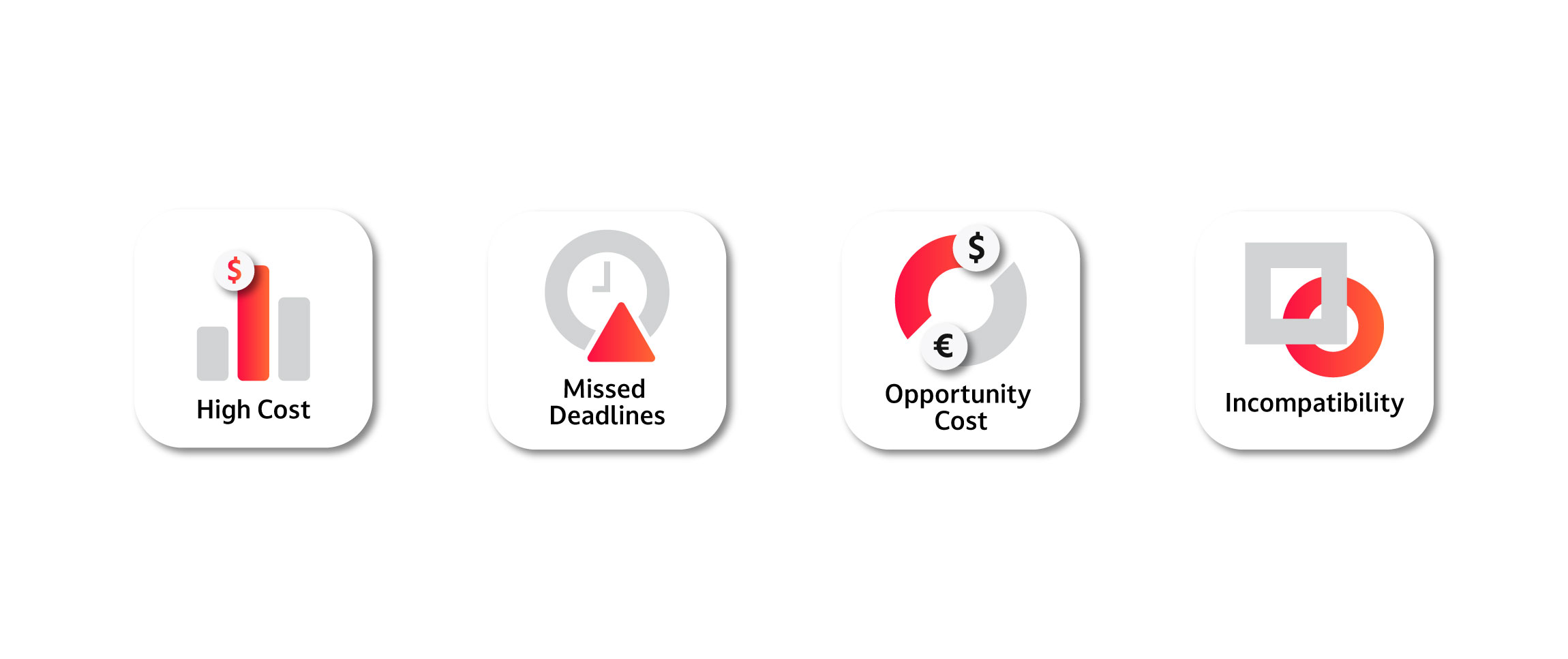The manufacturing industry has come a long way, with technology playing a key role in driving its growth and innovation. In recent years, the advent of no-code applications and custom software solutions has allowed the industry to modernize its processes and improve quality and efficiency. These technologies have enabled manufacturers to better connect with suppliers and vendors, as well as with distributed facilities and teams.
Let’s explore how software is transforming the manufacturing industry and what makes a strong foundation for innovation in any platform today. Understanding how the pieces fit together and what to avoid will help us understand how to build the future of manufacturing and establish a blueprint for an industry operating system.
Streamlined Production Processes
No-code and custom software are playing a significant role in streamlining production processes, allowing manufacturers to automate repetitive and manual tasks. By automating these tasks, manufacturers can increase production efficiency, reduce costs, and minimize errors. One example of how no-code applications are used to streamline production processes is through automation tools such as workflow process automation. Custom workflow automations built without a single line of code can be used to automate manual tasks, such as data entry, inventory management, and order fulfillment, allowing manufacturers to improve productivity and reduce errors.
In addition, manufacturers are using custom software to streamline their production processes. This can be tailored to the specific needs of each manufacturing facility for greater efficiency and productivity. For example, a custom software solution could be developed to automate the scheduling of production, which would eliminate the need for manual scheduling and reduce downtime in production.
Improved Quality Control
No-code platforms and other software are also used to improve quality control processes in the manufacturing industry. By automating quality control processes, manufacturers can reduce errors and improve the accuracy of their products. One example is through the use of artificial intelligence (AI). AI can be used to analyze data and detect anomalies so manufacturers can identify quality control issues before they become major problems.
In addition to AI, manufacturers are using software to improve quality control. This can be used to monitor the quality of raw materials and finished products. For example, a custom program could be developed to track the temperature and humidity levels of a production line to ensure that the finished product meets quality standards.
Greater Connectivity with Suppliers and Vendors
No-code apps and custom software solutions are also enabling manufacturers to be more connected with their suppliers and vendors. By creating a digital ecosystem, manufacturers can improve supply chain management, reduce costs, and increase productivity. One example of how no-code applications are used to improve connectivity with suppliers and vendors is through cloud-based collaboration tools. These tools allow manufacturers to share data and collaborate with their suppliers and vendors in real time, improving communication and reducing lead times.
In addition, manufacturers are using custom software to automate the procurement process, reducing the need for manual intervention and increasing efficiency. For example, custom triggers could be created to automatically place orders with suppliers when inventory levels reach a certain threshold.
Another useful tool is a vendor portal. Vendor portals can bring several benefits to a manufacturing company like improved communication. By providing a centralized platform for communication, manufacturers can streamline the exchange of information, reduce miscommunication and errors, and ensure that all parties are on the same page. With real-time data and analytics, they can respond to changes in demand and supply more rapidly, optimizing production and reducing lead times.
Distributed Facilities and Teams
No-code applications and software tools also play a significant role in helping manufacturers manage distributed facilities and teams. By creating a digital infrastructure, manufacturers can improve communication and collaboration across multiple locations, resulting in greater efficiency and productivity. One example is through the use of project management software, which allows manufacturers to track progress and collaborate on projects in real time, regardless of location.
Additionally, with a secure platform for data exchange and collaboration, vendors can help manufacturers protect their intellectual property and reduce the risk of supply chain disruptions by streamlining procurement, improving communication, reducing lead times, as well as automating manual processes and providing real-time data from any location.
Meaningful Insights Thanks to Data Analytics
Improving data analytics capabilities is where software solutions, including no-code, shine. By analyzing data in real time, manufacturers can make informed decisions about production processes, quality control, and supply chain management. One example of how no-code apps are used to improve data analytics is through business intelligence (BI) tools. These tools can analyze data from multiple sources, providing manufacturers with valuable insights into their operations.
In addition to BI tools, manufacturers build custom software to improve their data analytics capabilities. Tailored to the specific needs of each facility, it allows for greater insights and more accurate predictions. For example, a custom software solution could be developed to analyze production data in real time, providing manufacturers with information on which machines are performing optimally and which ones might require maintenance.
Manufacturing an “IndustryOS”
There’s no such thing as perfect software, but as technology advances, new platforms and solutions are communicating to augment each other. It’s important to understand what is required from systems to “play nice” in the modern world as you assess new solutions to improve business outcomes. To build the perfect platform for manufacturers, here are some key features you should consider to future-proof your software and make them work together.
- A modular design allows manufacturers to tailor the system to their needs. Each module can be developed to handle specific processes, such as inventory management, quality control, or production scheduling. The operating system should be customizable and able to integrate with other systems like enterprise resource planning (ERP), supply chain management, and customer relationship management (CRM) software.
- A cloud-based architecture allows manufacturers to access data from anywhere, providing greater flexibility and scalability. The system should be scalable, allowing manufacturers to add new modules or expand the system as needed. The operating system should have robust security features to protect sensitive data and prevent cyberattacks.
- Manufacturing software should provide real-time data tracking of all processes, allowing manufacturers to quickly identify bottlenecks and optimize production processes. Advanced analytics capabilities, such as predictive analytics, AI, and machine learning (ML), should be built into these systems to help manufacturers make informed decisions about their operations.
- Applications should have a user-friendly interface to minimize errors and increase productivity and should be accessible via mobile devices so managers and employees can access data from anywhere.
Overall, each system should be designed to improve efficiency, productivity, and quality control. By incorporating these key features, manufacturers can build an interoperable “operating” system that meets their specific needs and helps them stay competitive in a rapidly evolving industry.
Customizing Manufacturing Software Using No-Code Applications
Manufacturing companies are increasingly using no-code tools for process automation to improve efficiency and productivity, reduce costs, and accelerate innovation. No-code platforms allow non-technical users to build software applications without writing code, which can be useful for automating repetitive manual tasks that would otherwise require custom software development.
Manufacturing innovators use no-code tools to build automated quality control systems that can quickly and accurately detect defects or inconsistencies in products. With these tools, manufacturers can reduce errors and improve product quality.
As no-code software gets even more modular and customizable, it can adapt to nearly any need within a company. Maintenance workflows that track equipment performance, schedule maintenance, automate service requests, track production processes, and provide real-time data on production metrics such as cycle times, downtime, and defect rates are all being built with no-code.
No-code platforms are also exceptionally good at workflow and process management. Creating procurement workflows that automate the purchasing process by identifying suppliers, placing orders, and tracking inventory reduce procurement costs and improve supplier relationships by making it much simpler to do business. It can also help manufacturers ensure that they have the right inventory on hand to meet demand.
Overall, no-code tools are helping manufacturing companies automate processes, reduce costs, and accelerate innovation. By enabling non-technical users to build software applications without writing code, no-code platforms are democratizing access to technology and helping manufacturers to stay competitive in a rapidly evolving industry.
Building Your Own? Beware of These Challenges…
While custom software development offers many benefits to organizations, it also has several disadvantages like high cost, missed deadlines, opportunity cost, and incompatibility.
Developing custom software can be expensive, particularly if the application is complex or requires specialized skills. The cost of hiring developers, designing, developing, and testing the application can add up quickly, especially because it will inevitably require ongoing maintenance and support.
Additionally, it is time-consuming, particularly if the application is complex or requires specialized features. It can take several months or even years to complete the development process, which can delay the implementation, put pressure on the organization to deliver results because of missed opportunities, or cause it to revert back to legacy systems.
Once a custom software application is developed, it may be difficult to make changes or updates to the software, which can lead to integration issues with new software applications that may not be compatible with the new application. Changes will likely require additional development efforts, which only increase the cost.
In summary, custom software development can be expensive and time-consuming and may require technical expertise that may not be available in-house.
Modernizing Your Manufacturing Processes
The manufacturing industry is being modernized with no-code applications and custom software, allowing for greater efficiency, productivity, and connectivity. These technologies play a significant role in streamlining production processes, improving quality control, connecting manufacturers with suppliers and vendors, managing distributed facilities and teams, and improving data analytics capabilities. As the industry continues to evolve, it is clear that software will play an increasingly important role in driving growth and innovation.
At Kizen, we’re happy to help you make this transition with an industry-tailored, revenue-driving tool supercharging your business. We have the platform and expertise to deploy custom technology without disrupting your current operations and the resources to seamlessly integrate it with your existing software applications. Connect with us on our website, and we’ll schedule a time to chat.















